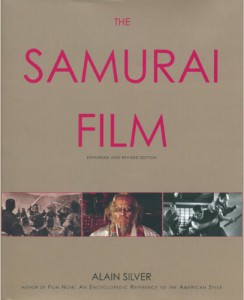The Samurai Film
by Alain Silver


Average rating: ![]()
| 0 | rating | |
| 0 | rating | |
| 0 | rating | |
| 0 | rating |
Your rating: -
Book Presentation:
Now illustrated throughout with color and black and white photographs and film stills; completely revised and up-to-date; and Praised in American Cinematographer as “the definitive study of this traditional movie genre,” Alain Silver's The Samurai Film is the ultimate resource for one of world cinema's most influential and compelling genres.
The image of a lone hero, marked by a violent past and bound by honor, has fascinated film audiences the world over, but nowhere more than in Japan where Samurai films have gained legions of passionate followers. Popularized by one of the greatest directors in cinematic history, Akira Kurosawa, the themes of the Samurai film continue to cross over into Western films, recent blockbusters include Crouching Tiger, Hidden Dragon, and Kill Bill.
The most astute Western analyst of this genre, Alain Silver deconstructs its key themes, from its focus on death and the significance of weaponry to key motifs such as hara kiri, and nostalgia for Japan's feudal past. With comprehensive filmographies of the major directors and films, a survey of the history and myths of the Samurai, a glossary of Japanese terms, and extensive illustrations including more than two hundred photos, The Samurai Film covers every aspect of this fascinating cinematic tradition.
Press Reviews:
From Publishers Weekly : Although the samurai, a privileged warrior class deeply enmeshed in Japanese feudal society, vanished nearly a century and a half ago with the restoration of the Meiji dynasty, the cinematic icon lives on, in one form or another, mixing history and myth in a popular and widely influential genre. By the heyday of the 1960s, works in the samurai (or chambara) genre by seminal directors Akira Kurosawa, Hideo Gosha and others had turned its aesthetics of violence into some of the finest specimens of narrative cinema anywhere. As new generations of cinemagoers-inspired by films like Crouching Tiger, Hidden Dragon (2000), House of Flying Daggers (2004) or Tarantino's samurai homage, Kill Bill (Vols. I and II)-seek out examples new and old of "the operatic complications and physical magic of the swordplay movies," they will find respected film analyst Silver's survey of enduring value. Silver's revised and expanded version of his 1977 study (first revised in 1983) offers not only close readings and discriminating assessments of major films and filmmakers but a wealth of insight into the history, philosophy and politics bearing on the chambara film in all its permutations and lines of influence. Complete with a generous array of photos, sophisticated filmography and glossary of Japanese terms, this volume will be an indispensable reference for serious fans and an excellent starting point for neophytes. But it's also a detailed, penetrating read for anyone interested in film history, especially as a gateway into some fascinating strains in Japanese culture and its ongoing dialogue with the West. Copyright © Reed Business Information, a division of Reed Elsevier Inc. All rights reserved.
Press Reviews:
"'The definitive study of this traditional movie genre' American Cinematographer"
See the publisher website: Overlook
> From the same author:
From the Moment They Met It Was Murder (2024)
Double Indemnity and the Rise of Film Noir
by Alain Silver and James Ursini
Subject: One Film > Double Indemnity
Movies Without Baggage (2022)
A Guide to Ultra-Low-Budget Filmmaking
by Alain Silver and Obren Bokich
Subject: Technique > Amateur cinema
> On a related topic:
Transcendence and Spirituality in Japanese Cinema (2024)
Framing Sacred Spaces
Cinema of Discontent (2023)
Representations of Japan's High-Speed Growth
Japanese Filmmakers in the Wake of Fukushima (2023)
Perspectives on Nuclear Disasters
Prostitutes, Hostesses, and Actresses at the Edge of the Japanese Empire (2023)
Fragmenting History
Film Viewing in Postwar Japan, 1945-1968 (2022)
An Ethnographic Study
Routledge Handbook of Japanese Cinema (2022)
Dir. Joanne Bernardi and Shota T. Ogawa